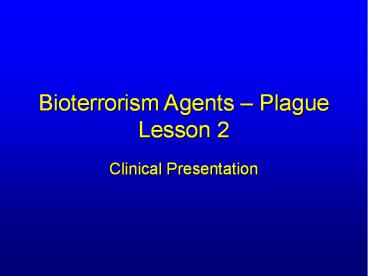Bioterrorism Agents - PowerPoint PPT Presentation
Title:
Bioterrorism Agents
Description:
Title: Plague Training Module - Lesson 2: Clinical Presentation Subject: plague Author: Centers for Disease Control and Prevention (CDC) Last modified by – PowerPoint PPT presentation
Number of Views:269
Avg rating:3.0/5.0
Title: Bioterrorism Agents
1
Bioterrorism Agents PlagueLesson 2
- Clinical Presentation
2
Objectives
- Identify distinctions between
- Bubonic Plague
- Pneumonic Plague
- Septicemic Plague
3
Bubonic Plague
- Incubation 2 to 6 days
- Symptoms
- Lymphadenopathy, fever
- Buboes at site of inoculation
- Disease Progression - Untreated
- Septicemia
- Secondary Pneumonic Plague
- Meningitis (rare)
4
Bubonic Plague
5
Bubonic Plague
6
Bubonic Plague
7
Pneumonic Plague
- Incubation 2 to 4 days (range 1 to 6 days)
- Symptoms
- Acute fever, chills, malaise, myalgias
- Productive cough
- Watery mucoid sputum, may be bloody
- Associated chest pain, increasing dyspnea
8
Pneumonic Plague
- Disease Progression
- Adult Respiratory Distress Syndrome
- Refractory pulmonary edema
- Signs of shock
- Without treatment in less than 24 hours, almost
universally fatal
9
Pneumonic Plague
- Coughing patient can spread
- Respiratory precautions
- Rapidly expanding infiltrates
- Pulmonary parenchymal necrosis and hemorrhage
- Occasional pulmonary abscesses
- Enlarged hilar nodes and pleural effusions
10
Pneumonic Plague
11
Pneumonic Plague
12
Pneumonic Plague
13
Septicemic Plague
- Incubation Most common as complication of
pneumonic or bubonic plague - Symptoms
- Acute fever, chills, prostration, abdominal pain,
nausea, vomiting - Disease Progression
- Purpura
- DIC
- Hypotension and other signs of shock
- Fatal if not treated
14
Other Plague Presentations
- Pharyngeal Plague
- Uncommon
- Resembles tonsillitis with
- peritonsillar abcess
- Cervical lymphadenopathy
- Plague Meningitis
- Most common in children
- Usually end result of ineffective treatment of
other forms - Symptoms mimic other forms of acute plague
15
Infection Control
- Large numbers of plague bacilli
- Respiratory droplet spread in close direct
contact - Respiratory droplet precautions with suspect
cases - Contact public health
16
Review Questions
- Plague Lesson 2
17
Plague Review QuestionsLesson 2, Question 1
- Gary, Indiana hospital
- 12 month old from Gary
- Acute onset fever, malaise, body aches x 2 days
- Extremely tender lymph node under arm, 2 inches
- Exhibiting neurologic symptoms
- Suspect plague meningitis. First step?
18
Plague Review QuestionsLesson 2, Question 1
- What is your first step?
- Call local health department
- Rule out other diseases
- Place in isolation
19
Plague Review QuestionsLesson 2, Question 1
- What is your first step?
- A. Call your local health department
20
Plague Review QuestionsLesson 2, Question 2
- Patient presents after 24 hours with no treatment
- How would you expect the patient to progress?
21
Plague Review QuestionsLesson 2, Question 2
- How would you expect the patient to progress?
- It should resolve on its own
- Septicemia, pneumonia, meningitis
- Entire appendage involved. Amputation.
- Kidney failure
22
Plague Review QuestionLesson 2, Question 2
- How would you expect an untreated patient to
progress? - B. Septicemia, pneumonia, meningitis
23
BT Agents Home
Plague Lesson 2- Clinical Presentation
BT Agents
Module Plague
A. The best choice is B. B. Correct. Adult
respiratory distress syndrome (ARDS)
characterized by refractory pulmonary edema may
occur. Signs of shock including hypotension and
eventual multi-organ failure may also occur.
Without early detection and treatment in less
than 24 hours, pneumonic plague is almost
universally fatal. C. The best choice is B D.
The best choice is B
3) You have a patient who you suspect has
pneumonic plague. What is likely to happen if
treatment is not offered within 24 hours?
Module Introduction- Module Objectives
Target Audience Continuing Education Credit
Lessons-1) General Overview 2) Clinical
Presentation 3) Differential Diagnosis 4)
Laboratory Issues 5) Medical Management 6) Public
Health Issues 7) Veterinarian Issues 8) Module
Self-Assessment Additional Resources
A. Once plague has progressed to the pneumonic
form, it is too late for treatment to be offered.
B. Without treatment within 24 hours, pneumonic
plague is almost always fatal.
C. It will progress to the bloodstream and cause
septicemic plague.
D. There is no progression of disease in cases
of bubonic plague.
Plague Lesson 2- Clinical Presentation
9 of _
Do you want to review?
Next
Back
24
Plague Review QuestionsLesson 2, Question 3
- Suspect pneumonic plague
- What will happen without treatment in 24 hours?
25
Plague Review QuestionsLesson 2, Question 3
- What will happen without treatment in 24 hours?
- Its too late for treatment
- Almost always fatal
- Septicemia
- No progression
26
Plague Review QuestionsLesson 2, Question 3
- What will happen without treatment in 24 hours?
- B. Almost always fatal































